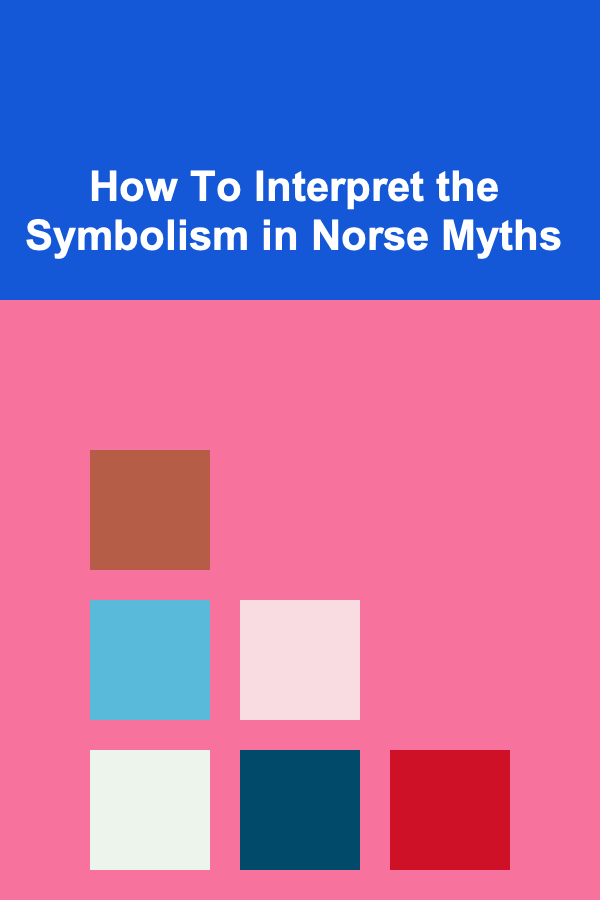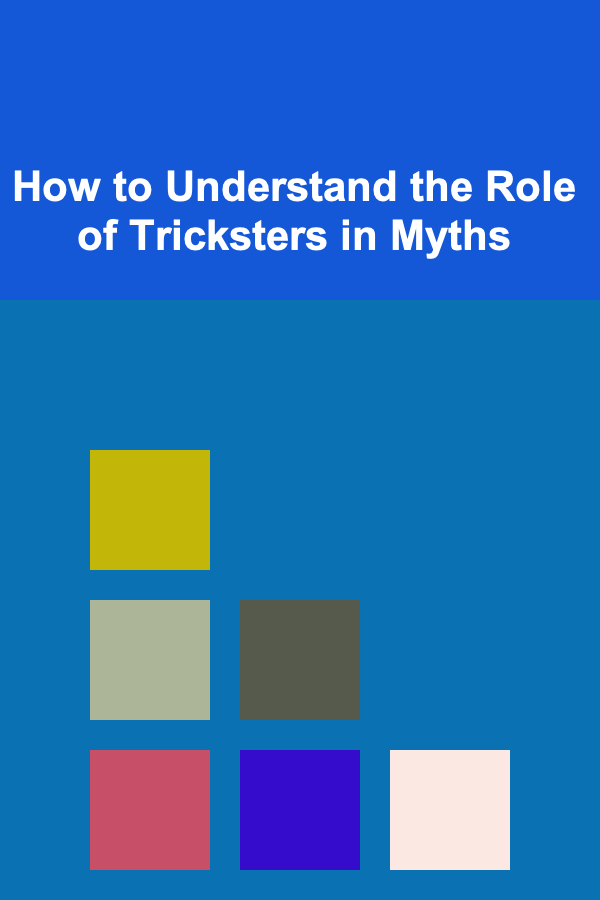
How To Interpret the Symbolism in Norse Myths
ebook include PDF & Audio bundle (Micro Guide)
$12.99$11.99
Limited Time Offer! Order within the next:

Norse mythology, with its vast array of gods, giants, and cosmic elements, is rich in symbolism. From the powerful god Odin to the immense serpent Jörmungandr, each figure, story, and object within Norse myth is laden with deeper meanings that reflect ancient ideas about life, death, fate, and the nature of the universe. The symbolism in Norse myths can be complex, but by examining the themes, deities, and events through the lens of both historical context and psychological analysis, we can uncover profound insights about human nature, cosmology, and existence itself.
This article explores how to interpret the symbolism in Norse myths, focusing on key figures, themes, and stories that encapsulate the Norse worldview. The focus will be on understanding the deeper layers of meaning within these myths, as they reveal fundamental aspects of life, death, power, and transformation.
The Worldview of the Norse
Before delving into the symbolism of the myths themselves, it's crucial to first understand the general worldview of the ancient Norse people. They believed in a universe with multiple realms interconnected by Yggdrasil, the world tree. At the center of this universe were nine worlds, which included realms such as Asgard (home of the gods), Midgard (Earth), and Helheim (realm of the dead). This cosmological view was not static but fluid, constantly in a state of flux and balance.
The Norse viewed the world as a place of constant struggle, where chaos and order were in perpetual conflict. They had a deeply fatalistic outlook on life, believing in the inevitability of Ragnarök, the prophesied end of the world. This view of the cosmos reflects a struggle between fate and free will, a recurring theme throughout their myths.
As we examine the symbolism within the myths, it is important to recognize that Norse mythology did not just serve as a religious system but as a cultural and philosophical framework that helped the Norse make sense of their lives, their environment, and the natural forces around them.
The Symbols of the Gods
Odin: The Allfather and the Raven
Odin, the chief of the gods in Norse mythology, is perhaps one of the most complex figures. He embodies the duality of wisdom and sacrifice. Odin is often depicted with one eye, having sacrificed the other to drink from Mímir's well of wisdom. His pursuit of knowledge, even at great personal cost, symbolizes the value the Norse placed on wisdom and understanding, often obtained through sacrifice and hardship.
Odin's two ravens, Huginn (thought) and Muninn (memory), are powerful symbols in themselves. These ravens fly across the world and bring information back to Odin. They represent not only the intellectual and mental faculties of thought and memory but also the idea of interconnectedness and vigilance. The ravens highlight Odin's quest for knowledge and the importance of maintaining awareness of both the present and the past in order to navigate the complexities of the world.
Thor: The Thunderer and the Hammer Mjölnir
Thor, the god of thunder, is another central figure in Norse mythology. He is best known for wielding Mjölnir, his hammer, which he uses to protect the gods and humanity from the giants. Mjölnir is a symbol of strength and protection, representing the ability to confront and overcome chaos. Thor's hammer is often seen as a symbol of masculinity and power, but it also symbolizes the essential role of defense and balance in society.
The symbolism of Thor's hammer extends beyond just physical protection---it also represents the idea of transformation. The hammer, though a weapon, is also used in rituals such as blessings of marriage and childbirth, highlighting Thor's dual role as a protector of both physical and spiritual realms. In this sense, Mjölnir symbolizes the transformative power of divine forces in the world, able to both destroy and create.
Freyja: The Goddess of Love and War
Freyja, the goddess of love, fertility, and war, embodies the balance between seemingly opposing forces. On the one hand, she is associated with beauty, sexuality, and the natural world; on the other hand, she is a fierce warrior, who also controls the Valkyries, female figures who choose those who die in battle and escort them to Valhalla. Freyja's symbolism is rich with themes of duality: the harmony between creation and destruction, love and war, life and death.
Her necklace, the Brísingamen, is one of her most prominent symbols. This necklace represents not just material wealth but also the deep connection between the goddess and the cycles of nature. Freyja's role in both love and war represents the Norse understanding of the interconnectedness of opposites in the natural world.
The Symbolism of Key Creatures
Jörmungandr: The World Serpent
One of the most iconic figures in Norse mythology is Jörmungandr, the enormous serpent who encircles the world. Jörmungandr symbolizes the destructive and cyclical forces of nature. According to the myths, when Jörmungandr releases its grip on the world, it signals the beginning of Ragnarök, the end of the world. This creature's symbolism lies in its embodiment of both the cyclic nature of life and death and the dangerous forces that must eventually be confronted in the battle against chaos.
Jörmungandr also represents the concept of balance---just as the serpent encircles the world, it is both the creator and destroyer of life. In this sense, it reflects the Norse understanding of life as a delicate balance between opposing forces. Jörmungandr's eventual battle with Thor at Ragnarök highlights the inevitability of this cosmic struggle.
Fenrir: The Wolf and Fate
Fenrir, the giant wolf, is another significant figure in Norse mythology, particularly in the story of Ragnarök. Fenrir's symbolism is rooted in the idea of fate and uncontrollable power. Despite the gods' attempts to bind him, Fenrir grows stronger, eventually breaking free to fight and kill Odin during Ragnarök. Fenrir represents both the destructive power of fate and the uncontrollable forces of nature that the Norse believed could not be tamed or predicted.
Fenrir's symbolism also speaks to the inevitability of certain events in life. The gods' failure to prevent Fenrir's rise mirrors the Norse belief in the inevitability of fate and the futility of trying to avoid it. This makes Fenrir a symbol not only of destruction but also of the inescapable forces that shape human existence.
The Themes of Life, Death, and Transformation
One of the most profound aspects of Norse mythology is its treatment of life, death, and transformation. These myths do not just offer narratives of gods and monsters but explore existential themes that resonate with the human experience.
Ragnarök: The End and Rebirth of the World
Ragnarök, the prophesied end of the world, is one of the most significant events in Norse mythology. It represents both the destruction and renewal of the cosmos. In the myths, the gods and their enemies engage in a final battle that leads to the death of many major figures, including Odin and Thor, and the destruction of much of the world. Yet, after this cataclysmic event, a new world is born, signaling a cyclical view of existence.
Ragnarök symbolizes the Norse belief in the cyclical nature of life, where destruction gives way to renewal. It also represents the idea that no matter how powerful one becomes, all things must eventually face their end, and from that end, new beginnings will emerge. This cycle of life, death, and rebirth is a central theme in Norse mythology and is reflected in both the gods' lives and the fate of humanity.
The Valkyries: The Choosers of the Fallen
The Valkyries, female figures who choose those who die in battle and guide them to Valhalla, play a vital role in Norse mythology. They symbolize the intertwining of life and death and the idea that life's greatest warriors will be rewarded in the afterlife. The Valkyries are not just agents of death; they also represent the valor, honor, and sacrifice that define a warrior's life.
Their role in selecting the worthy for Valhalla underscores the Norse value of honor and the belief that death in battle is not an end but a transition to a higher form of existence. The Valkyries' choice of who will ascend to Valhalla represents the Norse understanding of destiny and the fate of the warrior---an eternal cycle of life, death, and honor.
Psychological and Philosophical Interpretations
Norse mythology is not just a series of fantastical stories about gods and monsters; it can also be viewed through the lens of psychological and philosophical analysis. Carl Jung, a Swiss psychiatrist, famously analyzed myths and symbols as expressions of the unconscious mind. From this perspective, Norse myths offer valuable insights into the human psyche and the ways in which individuals and societies confront existential questions.
The figures of Odin, Thor, and Loki, for example, can be seen as representations of different psychological archetypes. Odin, the seeker of wisdom, represents the pursuit of higher knowledge and the wisdom that comes with age and experience. Thor, the protector, represents strength and resilience, while Loki embodies the trickster archetype, symbolizing chaos and change.
The psychological themes of balance, sacrifice, and fate that permeate Norse mythology also resonate with modern existential concerns. The Norse belief in the inevitability of death and the idea of embracing one's fate mirror contemporary understandings of mortality and the human need to find meaning in a world that often feels uncertain and chaotic.
Conclusion
Norse mythology is rich in symbolism, offering profound insights into the nature of the human condition, the forces of nature, and the cosmos itself. By interpreting the symbolism in these myths, we gain a deeper understanding of how the Norse people viewed the world and their place within it. The gods, creatures, and events of Norse mythology reflect timeless themes of life, death, fate, and transformation---concepts that continue to resonate with us today. Through their myths, the Norse not only sought to understand the forces shaping their lives but also to find meaning in a world filled with uncertainty, chaos, and change. In interpreting these symbols, we too can discover new ways to confront our own struggles and find meaning in the world around us.

Advanced Oral Care Procedures: Essential Skills for Today's Dental Hygienist
Read More
How to Manage Pet Anxiety and Stress at Home
Read More
How to Organize Craft Supplies for the Office
Read More
How to Use Rugs to Style Your Home on a Budget
Read More
How to Understand the Role of Tricksters in Myths
Read More
Choosing the Best Coffee Subscription Service: A Comprehensive Guide
Read MoreOther Products

Advanced Oral Care Procedures: Essential Skills for Today's Dental Hygienist
Read More
How to Manage Pet Anxiety and Stress at Home
Read More
How to Organize Craft Supplies for the Office
Read More
How to Use Rugs to Style Your Home on a Budget
Read More
How to Understand the Role of Tricksters in Myths
Read More